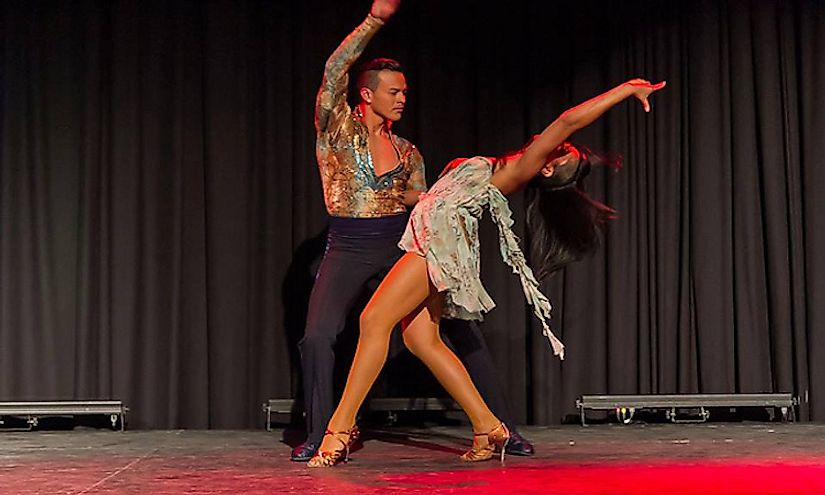Rumored Buzz on Dance San Francisco
Table of ContentsOur Dance San Francisco StatementsThe smart Trick of Dance San Francisco That Nobody is DiscussingGet This Report about Dance San FranciscoFascination About Dance San FranciscoLittle Known Questions About Dance San Francisco.The Facts About Dance San Francisco UncoveredSome Known Facts About Dance San Francisco.
The significant difference that identifies the Miami-style from other North American styles is the "Atras" or "Angled", back breaking actions done backwards diagonally rather of relocating forwards and backwards as seen in the New York style. Dancers do not change their body weight considerably as seen in other designs. bay area salsa dancing. Instead, professional dancers keep their top body still, positioned and unwinded, focusing on foot movementA significant difference in between Cali Style and Miami-style is the latter is exclusively danced on the downbeat (On1) and has aspects of shines and show-style included to it, following arsenals of North American styles. Miami-style has lots of adherents, especially Cuban-Americans and other Latinos based in South Florida. In the 1950s, Salsa Rueda or a lot more accurately Rueda de Gambling establishment was created in Havana, Cuba.
Several of the relocations involve quickly exchanging companions. "Rueda de Miami" stemmed in the 1980s from Miami, is a formal design with several regulations based on a mix, and is a hybridization of Rueda de Cuba & North American dancing styles, with some regimens showing American culture (e
Coca-Cola, Dedo, Adios) which is not found in the traditional Cuban-style Typical. Cali is likewise known as the "Capital de la Salsa" (Salsa's Resources); due to salsa music being the main genre in events, clubs and festivals in the 21st century.
Cali has the highest possible number of salsa institutions and salsa teams in the globe. The central attribute is the maneuvering which has quick rapid steps and missing movements called "repique".
Our Dance San Francisco Statements
They include numerous acrobats such as partnered turns to captivate with these jaw going down feats. Their footwork is elaborate and exact, helping several Colombian Style dancers win major globe champions. Cali hosts lots of annual salsa occasions such as the Globe Salsa Cali Celebration and the Encuentro de Melomanos y Coleccionistas.
Researchers in the all-natural scientific researches examined the mathematics of salsa dance steps. In the social sciences, researchers have actually researched salsa dancing go to my blog to comprehend, for example exactly how the Latino identification is connected to salsa dancing.
Centro Journal. Retrieved 2023-05-26. Salsa Vida.
Fetched 5 October 2023. " Background of Salsa Dance". Salsa Vida. 26 June 2023. Gotten 5 October 2023. Ludovic, Kiss Mihai (2015-10-01). " Salsa Origins and Development". Sporting activity i Societate. 15 (Special): 120129. ISSN 1582-2168. Djebbari, Elina (2020-01-02). " Dancing salsa in Benin: Connecting the Creole Atlantic". Atlantic Researches. 17 (1 ): 110134. doi:10.
Salsa Vida. Movers and Shakers Salsa & Bachata Dancing Academy. Spinning Mambo Into Salsa.
Gotten 2019-06-26. Waxer, Lise Aerinne (2002 ). The city of music memory: salsa, record grooves, and pop culture in Cali, Colombia. Music/culture. Middletown, Conn: Wesleyan College Press. ISBN 978-0-8195-6441-2. " Colombian Style Salsa". Salsa Vida SF. Recovered 27 July 2020. von Renesse, Christine; Ecke, Volker (2011-03-01). " Mathematics and Salsa dancing". Journal of Maths and the Arts.

Some Known Factual Statements About Dance San Francisco
:10. 1002/cb. Journal of Business Study.

Something went incorrect. Wait a moment and try once again Attempt once more.
How Dance San Francisco can Save You Time, Stress, and Money.
We're discussing the dancing, not the tasty South American dressing. The origins of the word "Salsa" as the name of a dancing has actually given argument for decades. The most preferred (and perhaps accepted) concept is that Cuban and Puerto Rican artists in New york city coined the expression in New york city in the 1970's, to explain the spicy fusion of music they were developing out of the rhythms and themes of Cuban child montuno, guaracha, chachacha, mambo and bolero.